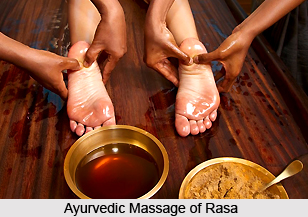 Rasa is one of the seven dhatus in Ayurveda. According to Ayurveda, Rasa is actually the first dhatu that is produced by the human body after digestion. Further, it is stated in Ayurveda that Rasa dhatu in human body gets generated and used every day. This preliminary dhatu of the human body mainly strengthens Rakta dhatu or blood by providing nourishment.
Rasa is one of the seven dhatus in Ayurveda. According to Ayurveda, Rasa is actually the first dhatu that is produced by the human body after digestion. Further, it is stated in Ayurveda that Rasa dhatu in human body gets generated and used every day. This preliminary dhatu of the human body mainly strengthens Rakta dhatu or blood by providing nourishment.
On the whole, tissue fluids of the body include blood plasma and lymph. In Ayurveda, it is defined that Rasa Dhatu is of two types - Pushya and Poshak. Pushya Rasa is motionless whereas Poshak Rasa is movable and moreover, Pushya is fed by Poshak Rasa. Ayurveda has also explained that value of Poshak gets produced regularly from the daily diet.
According to Ashtang Ayurveda, there are seven dhatus or tissues in the human body, which form the body`s foundation thus ensuring growth and survival. These dhatus are composed of the five elements of Ayurveda - earth, water, fire, air and universal space. Rasa, a flowing dhatu, is the lowest in the hierarchical order of the seven dhatus and is the preliminary source of the other tissues. A nutritious meal, comprising all the six rasas or tastes when properly digested and absorbed by the digestive system generates the body fluid or Rasa.
Ayurvedic medicine also defines Rasa Dhatu as the quality or the `guna` of any substance or drug used by human body. Rasa is also defined as the science of working of body minerals. Conventionally it is said that when mercury is prepared in the body properly, it helps in balancing the three doshas, prevents diseases and nourishes the fundamental parts of the body. This dhatu of Ayurveda is obtained from the digested food used by the body and is considered identical to plasma. In other words, Rasa gets formed in the body when `agni` digests the consumed food.
Importance of Rasa
In human body, when food gets properly digested with the aid of secreted digestive fluids, and the nutritive substance is known as Rasa. In Ayurvedic context, this nutritive fluid helps in nourishing the cells and tissues of the body. Rasa is equivalent to extra-cellular and intra-cellular body fluids. Rasa Dhatu provides sustenance to body`s every part by thorough circulation of nutrients. The main six categories of Rasa Dhatu are Madhura Rasa (sweet), Amla Rasa (acidic), Lavana Rasa (saline), Katu Rasa (pungent), Tikta Rasa (bitter), and Kashaya Rasa (astringent).




















